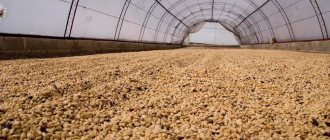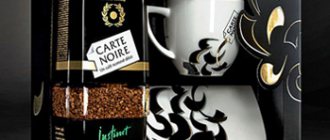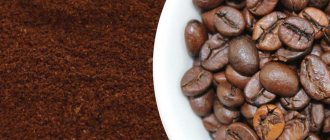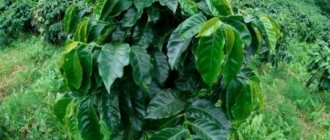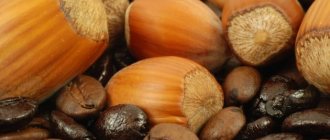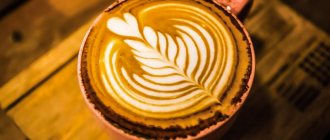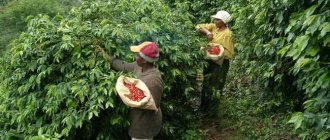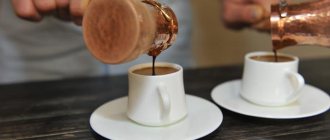Health conditions, fashion trends and personal beliefs may cause a person to abandon the consumption of natural coffee in favor of alternative decaffeinated products. The list of plant analogues is extensive, with a special place in it occupied by grain crops distributed throughout the world: barley, wheat, rye, oats. Barley as a coffee substitute has many beneficial properties, and dishes made from it can be very different.
Types of coffee
Varieties of coffee can be divided into several classifications:
- Grain variety
- Roasting degree
- Place of cultivation
Coffee bean variety
Of the dozen varieties of this plant in industrial production, 2 main ones are used to obtain good black coffee - Arabica (~70%) and Robusta (~30%). They make up 98% of all products.
Arabica is distinguished by a rich shade of flavors, soft, delicate, pronounced aroma. It is used both in 100% form and in mixtures. Requires close attention when growing. Vulnerable to diseases and climate change.
Robusta has a simple taste, sharp, bitter and weak aroma. Used only in mixture. Not picky in care, resistant to climate change and disease.
Roasting degree
Roasting coffee greatly affects its taste. Proper roasting determines how good the coffee will be. Intuitively, it can be divided into 3 main degrees: light, medium, high. But you need to understand that each degree has differences, even a few seconds of frying affect the taste and aroma in one way or another.
Light - this level is only suitable for high quality grains. Preserves the natural soft taste of good grains, with great sourness.
Medium is the most common roast level. Balanced taste, less acidic.
High - with this roasting, the grains acquire a stronger taste. It can also add bitterness.
Place of cultivation
Since coffee is a rather finicky plant, it grows only in the equator and tropics. There are some differences in taste depending on the place of growth; characteristic features are inherent in different zones.
South America - balanced taste, almost no bitterness.
Africa - in most cases has acidic, citrus undertones.
Asia - low acidity, earthy shade, bitter taste.
The largest coffee exports come from the following countries:
- Brazil - 30%
- Vietnam - 17%
- Colombia - 12%
- Ethiopia - 6%
- Indonesia - 5%
- India - 4%
The technology of making coffee in a coffee machine is a universal option for all types
A drink brewed under such “conditions” is characterized by medium density and the absence of coffee particles. The coffee machine is considered a universal option for brewing coffee of all varieties known today. Some, of course, may think that Uganda Robusta is somewhat harsh in this design. But here, as they say, there are no comrades according to taste.
The main rule for operating coffee machines is cleaning after each use. Otherwise, coffee particles adhering to the walls of the device may cause an unpleasant taste to the subsequent drink prepared in it. You can find out how to clean it from the instructions that came with the coffee machine or from the information provided on the manufacturer’s website.
Types of coffee drinks
What is espresso?
The basis of all coffee drinks is a drink called espresso. Espresso is prepared by flowing hot water under pressure (about 90°) through a filter with ground coffee. This is why it is called “espresso”, which means “squeezed” in Italian.
All coffee drinks are based on espresso and by adding milk, cream, ice cream, chocolate, whiskey or even lemon juice we get various delicious coffee drinks.
What is coffee made from?
Coffee is made from the seeds or beans of the coffee tree. Coffee beans contain more than 100 chemicals, including aroma molecules, proteins, starches, oils, and bitter phenols (acidic compounds), each of which has its own distinct, unique coffee flavor. The coffee tree, a member of the evergreen family, has waxy, pointed leaves and jasmine-like flowers.
Actually more like a shrub, the coffee tree can grow up to 9 meters in its wild state, but is usually pruned to between 1.5 and 3.5 meters when cultivated. Once planted, a typical tree will not produce coffee beans until it flowers, a process that typically takes about five years.
After the white petals fall off, red fruits appear, each containing two green coffee beans. Industrial production of beans requires a large number of trees: in one year, 400-500 grams of coffee can be harvested from a small bush. Because coffee cherries ripen unevenly, harvesting requires careful selection of only red ripe berries: including unripe green ones and overly ripe black ones will affect the taste of the coffee.
Coffee trees grow best in temperate climates without frost or high temperatures. High altitude plantations, located between 900 and 1800 meters above sea level, produce low-moisture beans with great flavor. Due to the positive influences of volcanic soil and altitude, the finest beans are often grown in mountainous areas. Today Brazil produces about half of the world's coffee. One quarter is produced in other Latin American countries, and Africa accounts for about one-sixth of global supply.
There are currently about 25 species of coffee trees, determined by environmental factors such as soil, weather and altitude. The two main species are coffea robusta (robusta) and coffea arabica (arabica). The Robusta strain produces less expensive beans, mainly because it can be grown in less ideal conditions than the Arabica strain. When served, coffee made from Arabica beans has a deep reddish hue, while Robusta beans have a dark brown or black appearance.
Coffee made from two main components is significantly different. Robusta beans are typically grown in large plantations where the berries are ripened and harvested at one time, thereby increasing the percentage of under-ripe and over-ripe beans. Arabica beans, on the other hand, include the bulk of premium coffee, which are typically sold as a whole bean so customers can grind their own coffee. Whether in a cafe or brewed at home, coffee made from these beans has a more subtle and less acidic taste.
Production
Drying and peeling of fruits
To begin with, the coffee beans are harvested, a process still done by hand. The fruit is then dried and peeled using one of two methods.
The dry method is a more ancient, primitive and labor-intensive process. The fruits are laid out in the sun and raked and spread out again several times during the day. When they dry out to the point that they contain only 12 percent water, the pavers become wrinkled. At this stage they are processed manually or by machine.
When using the wet method, the husks are removed before drying. The fruits are first processed in a pulping machine, which removes most of the material surrounding the beans, but some of this glue coating remains after the pulp is cooked. This residue is removed by adding enzymes in tanks where their natural enzymes digest the sticky substance over a period of 18 to 36 hours.
Once removed from the fermenting tank, the beans are washed, dried with hot air and placed in large mechanical mixers called hullers. Huller will polish the beans to a clean, glossy finish.
Cleaning and sorting beans
The beans are then placed on a conveyor belt, which carries them past workers who remove sticks and other debris. They are then graded based on the size, location and height of the plantation where they were grown.
Once these processes are complete, workers select and package specific types and grades of beans to fill orders from the various roasting companies that will complete the bean preparation. When beans (usually robusta) are harvested in undesirable conditions—hot, humid countries or coastal areas—they should be shipped as quickly as possible, as such climates are conducive to insects and fungi that can seriously damage the cargo.
When the coffee beans arrive for roasting, they are again cleaned and sorted using mechanical devices to remove leaves, bark and other remaining debris. If the beans are not supposed to be defatted, they are ready to be roasted.
Decaffeination
If coffee can be defatted, this is done using two methods. The first is using a solvent, the second is called aqueous.
In the first process, coffee beans are treated with a solvent (usually methylene chloride) that leach out the caffeine. If this degreasing method is used, the beans must be thoroughly washed to remove any traces of solvent before roasting.
The water method involves steaming the beans to bring the caffeine to the surface and then scraping off that caffeine-rich layer.
Burning
The beans are roasted in huge commercial roasters according to procedures and specifications that vary between manufacturers (specialty shops typically buy the beans directly from the growers and roast them on site). The most common process involves placing the bean in a large metal cylinder and blowing hot air into it. An older method called staggering requires placing the beans in a metal cylinder, which is then rotated over an electric, gas or coal heater.
Regardless of the method used, roasting gradually raises the temperature of the beans to 220-230 degrees Celsius. This causes the release of steam, carbon monoxide, carbon dioxide and other volatiles, reducing the weight of the beans by 14 to 23 percent. The pressure of these escaping internal gases causes the beans to swell, increasing their volume by 30 to 100 percent. Roasting also darkens the color of the beans, gives them a crumbly texture, and causes chemical reactions that imbue the coffee with its familiar aroma (that it has not yet possessed).
After roasting, they are placed in a cooling vessel in which they are mixed while cold air blows on them. If the brewed coffee is of high quality, the cooled beans will now be sent through an electronic sorter equipped to detect and eliminate beans that come out of the roasting process too light or too dark.
If the coffee is pre-prepared, the manufacturer injects it immediately after roasting. Special grinding types have been developed for each of the different types of coffee makers, as each is best suited for coffee of a certain fineness.
Instant coffee
If coffee must be instant, then it is brewed using water in huge percolators. The extract is purified from the brewed coffee and sprayed into a large cylinder. As it falls down through this cylinder, it enters a warm air stream that turns it into a dry powder.
Package
Whole coffee beans are less susceptible to loss of aroma and flavor than other types of coffee and are usually packaged in foil bags.
Pre-ground coffee should be hermetically sealed, as it retains its basic qualities less well. It is usually packaged in impermeable plastic film, aluminum foil or cans.
Instant coffee easily absorbs moisture, so it is vacuum packed in tins or glass jars before shipping to retail stores
Making coffee video
Brewing by soaking
Brewing this way is fundamental and the oldest. In short, you simply mix ground coffee with hot water and brew. Then you leave the brewed coffee and throw away the coffee grounds.
Sounds simple. However, in brewing there is a fine line between too much and not enough: finish the brew too early and you'll end up with a weak taste, too late and your coffee will be too bitter. The good news is that it's not that difficult to learn and you'll end up with a great brew.
The most common steeping brewing method is the French press. We will also talk about Soft Brew and siphon.
What to expect
Time : Not very fast. From the moment the water boils until the coffee is completely brewed, it will take approximately 10 minutes. You will need to pay attention to the process.
Grinding type : Coarse grinding only. Grinding too fine will result in coffee particles not being filtered and ending up in the brewed coffee. The coffee will become too strong and taste bitter.
Taste : French press coffee is soft and aromatic. True, sediment will collect at the bottom, so you shouldn’t drink the coffee to the last drop.
Availability of skills : Not required, everything is very simple. But making the perfect coffee will be more difficult, but if you strictly follow the instructions, it should turn out well.
Suitable for : You like the unique taste of coffee brewed in a French press, if you have a large group of people or if everyone in your family drinks coffee.
Who it won't suit : Frequent travelers won't benefit from a glass French press.
Advantages:
- Unique taste
- Easy to use
- Ability to brew several cups of coffee at once
Flaws:
- It is difficult to “perfect” the brewing process
What to expect
Time : 4-8 minutes from the start of brewing.
Grinding type : Any will do! Space for experimentation.
Taste : Similar to French press. A special filter is provided for finely ground brew, which reveals a deep taste and rich body. Like a French press, only cleaner.
Availability of skills : Not required. You can make great coffee with your eyes closed. Soft Brew was developed for this very purpose.
Suitable for : You don't want to put in too much effort to brew a good cup of coffee, but you appreciate the quality of the drink.
Who it's not for : You like to experiment with making coffee and get creative with it. If this sounds like you, you'll quickly get bored with Soft Brew.
Advantages:
- Insanely easy to use
- Relatively fast
- Sold in different sizes
Flaws:
- Partly ceramic, so not designed for travel
What to expect
Time : About 10 minutes. By the way, washing the siphon is a real hassle.
Grind Type : Medium to coarse, about the same as a French press.
Palate : Very clean and rich when done right. Since the coffee is brewed only in glass, it will be one of the purest compared to the drink brewed by all other methods.
Availability of skills : Requires dexterity and strict adherence to instructions. If you are a chemist, then there will be no problems
